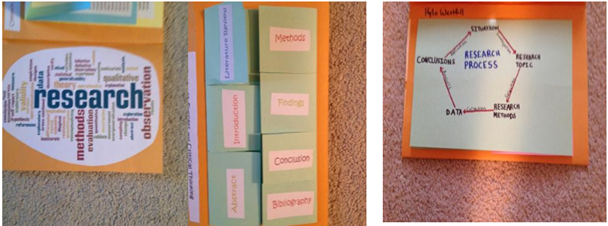Images and Videos of
Context
As Sundt (2010) observes, few courses in the criminal justice curriculum evoke more anxiety and resistance to learning than research methods. In her research, Sundt (2010) finds that, students often struggle to understand the relevance of research methods to their education and career goals, complain that the topic is tedious and difficult, and approach the course with a minimum of enthusiasm and more than a little dread (pg. 266).
My own experience teaching research methods echoes her observations. In course evaluations, students often note that the material is extremely difficult to understand and quite dry compared to other criminal justice topics and readily admit to a lack of self-motivation in learning the course material. One issue students’ note is the overwhelming amount of material they are exposed to in the course. Like many instructors, I fell into the trap of the "tyranny of content". As Weimer (1993: 26) argues, "content tyranny exists when the need to cover material rather than to encourage student learning dominates educators' teaching and testing styles". Given this is the only research methods course student's encounter in the criminal justice program, I often feel I should cover as much material in the textbook as possible. Instead of focusing on the primary skills and concepts students need in order to critically examine knowledge about criminal justice research, I was including an admittedly overwhelming amount of material and doing very little to help students focus on key areas of inquiry.
The change in strategy included the inclusion of a graphic organizer approach. Research has demonstrated that graphic organizers are an effective instructional strategy in improving student comprehension and application of concepts (Ogle, 2000). They help learners create connections between material, help students focus on key terminology and concepts, and teach them active note taking skills (Casteel & Narkawicz, 2012).
Step-by-Step Implementation
- Consider different methods of formatting organizers. Before using Foldables© instructors should become familiar with different ways students might format their organizers. There are a variety of strategies to use in organizing the material and the instructor will want to give students a few options for creating their organizers.
- Develop a guide. Instructors will want to ensure that they develop a thorough guide so students know exactly how they should organize the material. I developed a guide that walked students step by step through where they should add material and what specific material should be added.
- Create a rubric. Instructors will want to create a clear rubric explaining how students will be graded.
Effectiveness
Students are required to submit a final research project in this course. This project asks students to identify a research question they are interested in and to research and analyze the empirical evidence related to that question. Final project scores significantly improved after the incorporation of the Foldables©. The average grades for the projects and assessment of the number of application errors, both prior to and following modifications, are listed below:
|
Final Project Grades |
Fall 2012 Average |
Fall 2013 Averages (inclusion of weekly quizzes) |
Fall 2014 Averages (inclusion of modified quizzes and Foldables©) |
|
|
65% |
66% |
76% |
|
Errors in critical reasoning/application of concepts |
Fall 2012 Average |
Fall 2013 Averages (inclusion of weekly quizzes) |
Fall 2014 Averages (inclusion of modified quizzes and) |
|
2% |
2% |
8% |
|
5% |
10% |
19% |
|
13% |
16% |
13% |
|
80% |
72% |
60% |
Keywords
Associated tools or materials
- Foldables© approach to graphic organizing (Dinah-Might Adventures, LP, n.d.): A Foldable© is one particular type of graphic organizer that requires students to create a product that divides particular sections of course material. The use of Foldables© became a way to focus students toward the most important concepts for the course.
About this course
- Discipline: Criminal Justice
References
Dinah-Might Adventures, LP. Foldables®, VKV’s®, & Equivalency Flips™: Unique graphic organizers & manipulatives (no date). http://www.dinah.com.
Narkawicz, M. & Casteel, D.B. (2012). Improving accelerated college courses:
How Foldable® graphic organizers can help learners retain information. Delta Journal of Education, 2(2), 113-120.
Ogle, D.M (2000). Make it visual: A picture is worth a thousand words. In M. McLaughlin & M.E. Vogt (Eds.), Creativity and innovation in content area teaching (pp. 55-71). Norwood, MA: Christopher-Gordon
Pennebaker J.W., Gosling S.D., & Ferrell J.D. (2013). Daily online testing in large classes: Boosting college performance while reducing achievement gaps. PLoS ONE 8(11): e79774. doi:10.1371/journal.pone.0079774
Sundt, J. (2010). Overcoming student resistance to learning research methods: An approach based on decoding disciplinary thinking. Journal of Criminal Justice Education, 21(3), 266-284.
Weimer, M. (1993). Improving your classroom teaching. Sage Publications.



